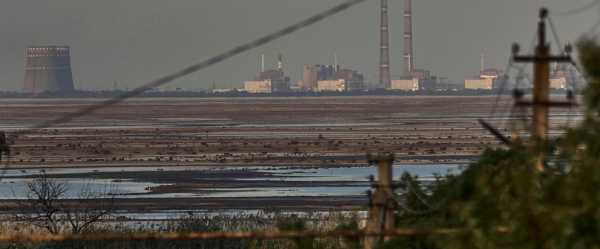
KYIV, Ukraine — The U.N. atomic watchdog says its staff at Ukraine’s Russian-occupied Zaporizhzhia Nuclear Power Plant report seeing anti-personnel mines around the site as Kyiv pursues a counteroffensive against the Kremlin’s entrenched forces after 17 months of war.
“Having such explosives on the site is inconsistent with the IAEA safety standards and nuclear security guidance and creates additional psychological pressure on plant staff,” International Atomic Energy Agency Director-General Rafael Mariano Grossi said in a statement late Monday.
However, any detonation of the mines, located between the site’s internal and external perimeter barriers, “should not affect the site’s nuclear safety and security systems,” the statement said.
The IAEA has repeatedly expressed concern about the facility, which is one of the 10 biggest in the world, amid fears of a potential nuclear catastrophe. The U.N. agency has officials stationed at the plant, which is still run by its Ukrainian staff.
The plant’s six reactors have been shut down for months, but it still needs power and qualified staff to operate crucial cooling systems and other safety features.
Ukraine’s military intelligence said last month without providing evidence that Russia is planning a “large-scale provocation” at the nuclear power plant in the southeast of the country and had placed suspected explosives on the roof. Russia, in turn, has alleged without offering evidence that Ukraine was planning a false flag attack involving radioactive materials.
The IAEA statement said that the Russian occupiers still haven't granted it access to the roofs of the reactors and their turbine halls.
Meanwhile, Ukrainian authorities said Tuesday that air defenses intercepted Iranian-made Shahed drones that Russia fired at Kyiv overnight, in what was the sixth drone attack on the capital this month. No casualties or damage were reported, according to Serhii Popko, head of the Kyiv regional military administration head.
The Russian Defense Ministry said a Russian patrol ship destroyed two Ukrainian sea drones that attacked it in the Black Sea early Tuesday. It said the crew of the Sergey Kotov patrol ship of the Russian Black Sea Fleet wasn’t hurt in the attack 370 kilometers (200 nautical miles) southwest of the Crimean port of Sevastopol.
Ukrainian officials, in turn, said that Russians used cluster munitions in an attack on Kostiantynivka, in the eastern Donetsk region, late Monday.
Rockets hit a recreational pond, killing a 10-year-old boy and wounding four other children ranging in age from 5 to 12, according to Pavlo Kyrylenko, head of the Donetsk regional military administration.
Russia and Ukraine have both used cluster munitions throughout the war, and the U.S. has recently provided them to Ukraine.
Western analysts said Tuesday that Russia's recent attacks on Odesa and other parts of southern Ukraine have employed missiles that were originally developed to destroy aircraft carriers.
Each missile weighs 5.5 metric tons, the U.K. Ministry of Defense said in an assessment.
In only a week, Russia has fired dozens of missiles and drones at the Odesa region, on Monday hitting a cathedral. The strikes have come since Moscow broke off from a landmark grain deal a week ago. Odesa is a key Ukrainian hub for exporting grain.
The attacks have damaged several grain silos at Chornomorsk Port, south of Odesa, and Russian drones have hit docks on the Danube River, approximately 200 meters (650 feet) from the Romanian border, according to the assessment.
___
Follow AP’s coverage of the war in Ukraine at https://apnews.com/hub/russia-ukraine
Sourse: abcnews.go.com






